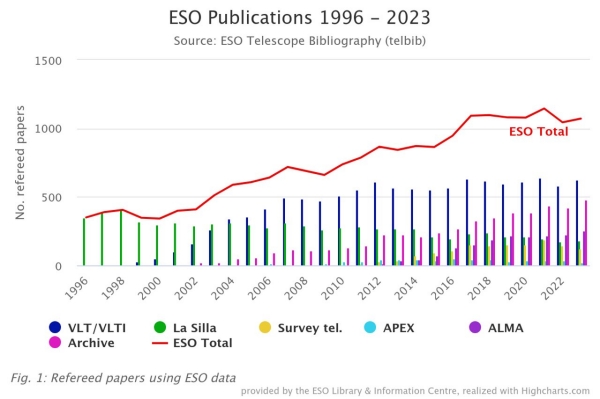For the seventh year in a row, observations conducted at ESO’s observatories have led to more than 1000 scientific publications in a year. Recently, the ESO Library, Documentation, and Information Services Department has updated their detailed statistics on publications using ESO data, presenting each facility's contributions in 2023.
More than 1000 Studies Using ESO Data Published in 2023

The most significant contributions to these publications come from ESO’s Very Large Telescope (VLT) and the VLT Interferometer (VLTI) at Paranal Observatory, which yielded data included in over 600 studies. For the last four years, the Multi Unit Spectroscopic Explorer (MUSE) has been the most productive VLT instrument, producing data for over 200 papers in 2023 alone.
Also located at Paranal Observatory, the Visible and Infrared Telescope for Astronomy (VISTA) and the VLT Survey Telescope (VST) contributed to over 120 publications (VST was a joint venture between ESO and the Capodimonte Astronomical Observatory, part of the Italian National Institute for Astrophysics (INAF). As of 1 October 2022, this is a sole project of INAF, hosted by ESO at Paranal). Further south, the telescopes at ESO’s La Silla Observatory contributed to approximately 185 studies.
Over the year, the Atacama Large Millimeter/Submillimeter Array (ALMA), in which ESO is a partner, provided data for almost 500 papers. As in the last three years, approximately half of them (53%) used data obtained through observing time granted to astronomers based in Europe.
Until December 2022, ESO was also a partner of the Atacama Pathfinder Experiment (APEX), located close to ALMA on the Chajnantor plateau in Chile’s Atacama region. Observations obtained during ESO observing time at APEX previous to 2023 contributed to 24 papers in that year, more than half (57%) of the studies from all APEX observing time.
The number of papers that partly or exclusively used archival data has increased continuously during recent years and remained high in 2023, making up almost 45% of all publications. In particular, almost 24% of papers relied on archival data alone, without any ESO observations obtained by the authors themselves. Even data from instruments that were decommissioned years ago still actively contribute to the pool of data papers. These figures demonstrate the important legacy value of the ESO Science Archive Facility.
The statistics presented here are derived from the ESO Telescope Bibliography (telbib), a database of refereed papers published by the ESO users community. Telbib is developed and curated by the ESO Library, Documentation, and Information Services Department. Whilst text-mining scripts are applied when screening the literature for ESO data papers, articles are carefully examined by the curators before they are added to the database to ensure that all telbib papers use partly or exclusively data from ESO facilities for which observing time was recommended by ESO. The public telbib interface provides visualisations of search results including on-the-fly graphs and predefined charts.
Researchers are asked to indicate the identifiers (programme IDs or Data DOIs) of the (new or archival) observations they used in their papers as explained in ESO’s data citation policy. This enables the telbib curators to cross-link research output to make data Findabie, Accessible, Interoperable, and Reusable as suggested by the FAIR Principles.
